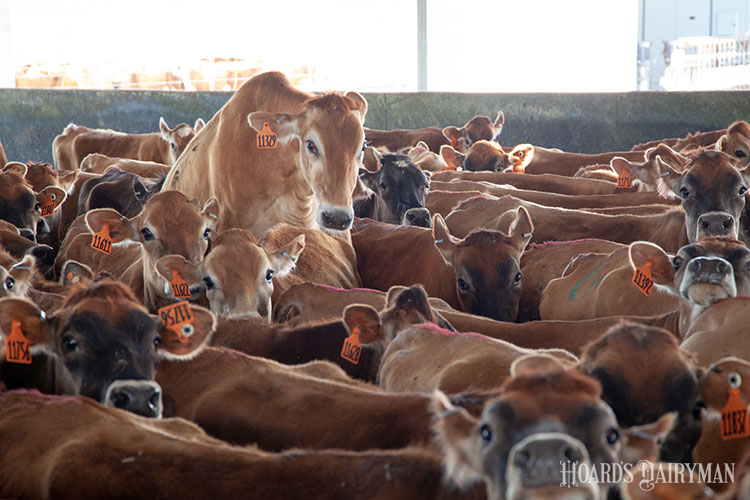
“If you can get your herd into the high fertility cycle by being aggressive with reproduction. Everything is going to just work better,” explained Paul Fricke, a dairy cattle reproduction physiologist at the University of Wisconsin. He and lead researcher Megan Lauber visited the Dairy Science Digest podcast to discuss their recently released research investigating the effectiveness of the Double-Ovsynch (DO) protocol when Jerseys are bred to sexed or beef semen.
Equation of reproduction

The intersection of these two metrics creates the opportunity for pregnancy. Both were measured in this study.
When cows are submitted to double ovsynch, the end of the program is breeding. Period. Semen is inserted with the hope that it will meet a fertile egg. In this study, when the team relied on estrus detection, about 25% of animals were missed. Despite dedicated staff and tail chalk, the cows simply didn’t show estrus or were anovular. First lactation cows were the worst offenders, showing estrus only 70% of the time. Therefore, an advantage to the sync program is there’s a 100% chance the “left side” of the equation won’t hold the herd back.
To the “right side” of the equation:
- Beef semen pregnancy/A.I. rates 58% for DO and 49% for estrus
- Advantage of 6% when using Double-Ovsynch over estrus for sexed semen
- No effect of parity on sexed semen pregnancy/A.I.
What about energy balance?
Thin cows coming into breeding season spells trouble, with a capital T. For years, we’ve understood that a cow entering into the breeding season run down from a poor transition will fail to conceive. Initially, Jack Britt documented the impact of body condition score in 1992. At this point, many herds have created transition programs to address this important phase of production. However, on occasion, a group struggles through and thins down. While not a magic eraser, double ovsynch holds promise to help minimize the effect of a poor transition.
For this study, Lauber organized the herd of 865 Jerseys by body condition score change to understand the energy impact on fertility. The groups were: 1. Aggressive loss (>0.5 pt); (2) Moderate loss (>0.25 pt); or (3) Zero loss/gain.
- 56% pregnancies/A.I. for cows maintaining BCS and enrolled in DO
- 36% pregnancies/A.I. for cows who lost >0.5 enrolled in estrus detect
- 15% improvement in pregnancies/A.I. for estrus detected cows who maintained versus lost >0.5 BCS
“There’s not a lot of dairy research out to describe why this is happening, because it is so hard to measure,” Lauber described. “But if we look to the sheep as a model, it’s been documented that leptin, a hormone from fat, has a role in initiating the cascade of events that ultimately results in ovulation.”
Specifically, gonadotropin releasing hormone (GnRH) starts the cascade, and its thought that leptin could play a key role in the release. Double ovsynch exposes the cow to multiple exposures to GnRH potentially eliminating the negative effect of decreased circulating leptin.
Lauber reminds producers that not all cows have to lose condition in your early lactation pen. The goal, without wavering, is to minimize loss, with a recommended BCS of 3 at calving. Cows with stable BCS produced the same volume of milk in this study.
The details matter
Synchronization protocols are complex. Write them down, and be compliant; the timing matters. When used correctly, the program reaps dividends with the opportunity to get nearly half the herd pregnant first service.
When using the double ovsynch protocol, Fricke encourages the use of a second prostaglandin treatment on day 25 of the program (breeding week). “We see fertility pop,” he described. “The back-to-back prostaglandin treatments allow for full luteolysis of the corpus luteum (CL). We’ll see a 14% to 15% improvement in luteal regression with producers who adds the second prostaglandin treatment to the program.”
The high fertility cycle
Boots on the ground dairy producers have the ability to impact every part of the equation for a successful reproduction record. If committed to success, these sync protocols will propel your herd into the high fertility cycle. This is when improved reproduction results in less time spent in late lactation, where cows are generating less income and getting fat. Moderate BCS improves reproduction in the following lactation; therefore, the positive cycle begins to immerge.
The high fertility cycle will unlock the potential to stack your reproductive technologies such as genomic testing and strategic culling. This allows the farm to add value to the calf crop, using sexed and beef semen more successfully. If a herd struggles with reproduction, these are simply not options because all heifers are retained for replacements.
The evolution of reproductive physiology over the past three decades has paved the way to overall financial success of your dairy operation. This current research shows if you measure BCS change, aggressively implement sync tools, and strategically breed your herd, you’re charting a path for a successful future with a healthier, more productive herd.
These findings were summarized in a peer-reviewed open access Journal of Dairy Science article found at: www.journalofdairyscience.org. To learn more, listen in to the monthly podcast, Dairy Science Digest on your favorite podcast platform.








